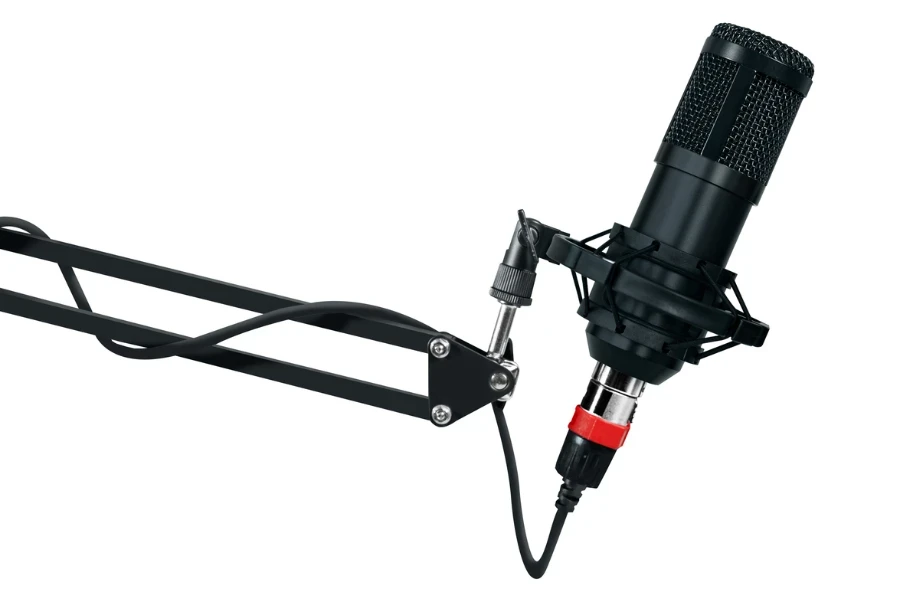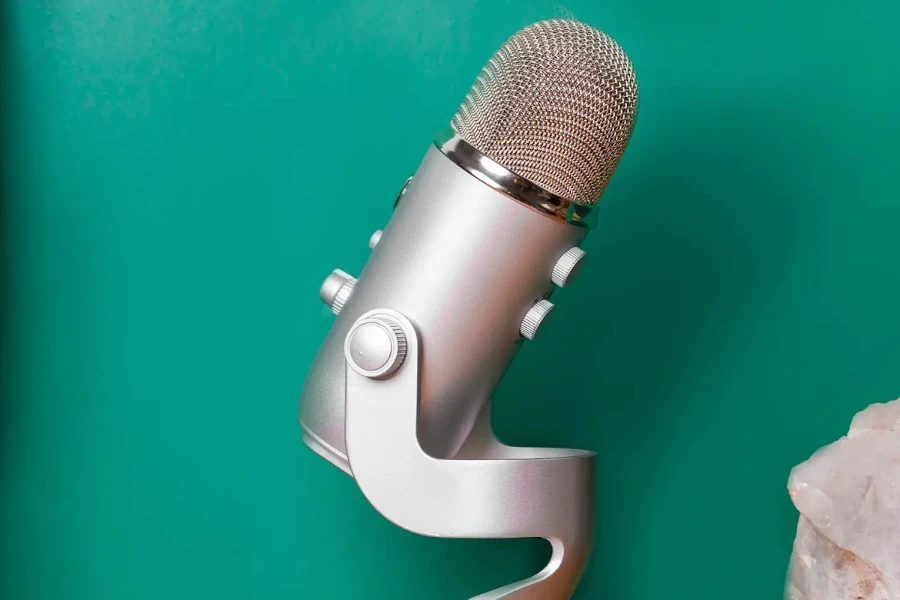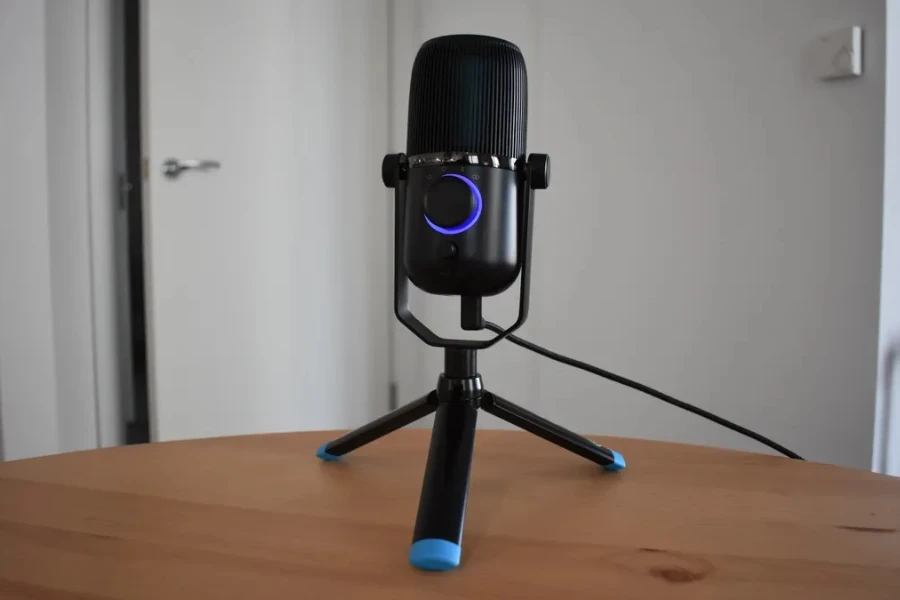In the dynamic landscape of 2024, microphones have transcended their traditional roles, becoming pivotal assets in diverse industries. From facilitating crystal-clear corporate communications to ensuring impeccable audio quality in multimedia projects, the right microphone can elevate the professional standard, driving efficiency and enhancing user experiences. As the world leans more into digital communication and content creation, the microphone’s role as an indispensable tool for businesses becomes ever more pronounced.
Table of Contents
Decoding the microphone market: Key data points
Precision in product selection: Factors to consider
Spotlight on 2024’s top microphone models and features
Conclusion
Decoding the microphone market: Key data points

Global demand and supply trends
The value of the global microphone market has witnessed a significant surge, which is projected to expand from USD 2,454 million in 2023 to an estimated USD 3,526 million by 2028. This growth represents a Compound Annual Growth Rate (CAGR) of 7.5% over the five-year period from 2023 to 2028, showcasing the increasing demand for microphones across various sectors. This growth can be attributed to several factors:
Rise of IoT devices: The proliferation of Internet of Things (IoT) devices has played a pivotal role in the microphone market’s expansion. As more devices become interconnected, the need for high-quality microphones to facilitate clear communication becomes paramount.
Professional microphone market growth: The professional microphone segment alone is anticipated to hit $3,043 million in 2023, growing at a Compound Annual Growth Rate (CAGR) of over 2%. This indicates a rising demand in professional settings, from broadcasting to corporate communications.
Manufacturing and supply chain dynamics: While the sources provided insights into the top microphone models and their features, understanding the manufacturing hubs and supply chain dynamics is crucial for retailers. This ensures timely stock replenishments and an understanding of market shifts.
Technological advancements and their impact
Microphone technology has not remained stagnant. Recent innovations have significantly influenced consumer preferences:
MEMS microphones: The global MEMS (Micro-Electro-Mechanical Systems) microphone market size was noteworthy, indicating a shift towards these compact, efficient, and technologically advanced microphones [Bloomberg].
Digital transformation: The introduction of digital wireless technology in microphones has revolutionized audio quality, offering clearer sound without the constraints of cables.
Adaptive audio patterns: As highlighted in our primary source, microphones now come with multiple audio patterns like Cardioid, Bidirectional, Omnidirectional, and Stereo. These advancements allow users to adapt to various recording environments, ensuring optimal sound quality.
Incorporating these technological trends into product selection can give online retailers an edge, ensuring they stock products aligned with contemporary demands and preferences.
Precision in product selection: Factors to consider

Determining the microphone’s primary purpose
The microphone market offers a plethora of options tailored to specific needs. For instance, while a microphone designed for voice calls prioritizes clarity and noise reduction, one for music recording seeks to capture a broader range of frequencies. Similarly, voiceovers demand a neutral tone, ensuring the voice remains true to its natural timbre. On the other hand, live streaming microphones often come with features like programmable RGB, catering to the aesthetics of the streaming setup. Recognizing the primary purpose of the microphone is paramount to ensure optimal performance.
Understanding audio patterns
The audio pattern of a microphone determines its sensitivity direction. According to Tom’s Guide:
Cardioid: This pattern captures sound primarily from the front, making it ideal for podcasts, streaming, and voiceovers. It minimizes background noise, focusing on the speaker’s voice.
Bidirectional: Capturing sound from the front and back, bidirectional microphones are perfect for face-to-face interviews.
Omnidirectional: These capture sound from all directions, suitable for recording ambient noise or group discussions.
Stereo: Stereo microphones record multi-directional sound, offering a more immersive experience, especially for music recordings.

Price vs. Quality
While it’s tempting to opt for premium microphones like the Shure SM7B, lauded for its exceptional vocal capture, it’s essential to balance cost with performance. For budding streamers or those on a budget, options like the Blue Snowball Ice offer commendable quality without breaking the bank. However, as one progresses and seeks to upgrade, investing in higher-end microphones can significantly enhance audio quality.
Connectivity and compatibility
The connection type of a microphone plays a crucial role in its compatibility and use-case scenarios:
USB microphones: These are plug-and-play, requiring no additional equipment. They’re perfect for beginners and are widely compatible with most devices.
XLR microphones: Offering superior sound quality, XLR microphones, like the Shure SM7B, require an audio interface. They’re favored by professionals seeking the best audio capture.
3.5mm microphones: These are typically used for smaller devices like smartphones and some cameras. While convenient, they might not offer the same audio quality as their USB or XLR counterparts.
Incorporating these considerations ensures that retailers stock products that not only meet but exceed their clientele’s expectations.
Spotlight on 2023’s top microphone models and features

Blue Yeti: The all-rounder
The Blue Yeti stands out as a versatile microphone suitable for a range of applications. According to Tom’s Guide, its four different pattern modes – Cardioid, Bidirectional, Omnidirectional, and Stereo – make it adaptable to various recording environments. This flexibility, combined with its competitive price point, positions the Blue Yeti as a top choice for both beginners and professionals.

JLab Talk: Best value proposition
For those seeking quality without a hefty price tag, the JLab Talk offers an impressive solution. Futurism highlights its commendable sound quality and ease of setup. Its affordability doesn’t compromise its performance, making it an excellent value proposition for retailers looking to cater to budget-conscious consumers without sacrificing quality.

Rode PodMic: The podcaster’s choice
Podcasting has seen a meteoric rise, and the Rode PodMic is tailor-made for this niche. With its fantastic sound quality, internal pop filter, and robust build, it’s no wonder PianoDreamers recommends it for podcasting. Its design ensures that voices are captured naturally, making it a favorite among podcasters.
Sennheiser MD 421 II: Studio excellence
For those in the music industry or professional recording studios, the Sennheiser MD 421 II is a name that resonates with quality. Its versatility in studio settings is unmatched, and its ability to reject feedback is unparalleled. Its reputation as a studio workhorse is well- deserved.
Shure SM7B: Vocal brilliance
The Shure SM7B is synonymous with vocal brilliance. Whether it’s for singing, voiceovers, or broadcasting, its ability to capture vocals with clarity and depth is exceptional. Its electromagnetic hum shielding ensures that external interferences don’t compromise the recording quality, making it a top pick for professionals, as highlighted by Futurism.
Conclusion
In the rapidly evolving world of audio technology, staying updated with the latest microphone models and their features is paramount. By understanding the unique selling points of each model and aligning them with consumer needs, online retailers can position themselves for success. As 2023 unfolds, the right product selection, backed by informed decisions, will be the cornerstone of retail success in the microphone market.




